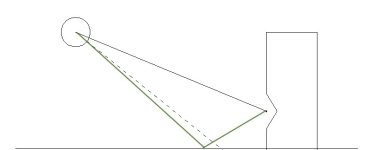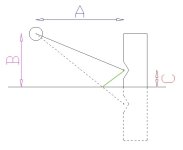I’ve got a project in mind that hasn’t progressed to even a sheet of paper. It’s for the long term since I’m broke at the moment, but it’s fun to plan for when I’m no longer broke.
I’m considering a three-way using an 18” woofer in a sealed cabinet. What is the spacing above the floor that I need in order to couple to it? While I’m at it, I might as well ask about the center-to-center distance between the woofer & midrange at a crossover frequency of 500Hz with a 12dB slope.
Thanks, as always.
I’m considering a three-way using an 18” woofer in a sealed cabinet. What is the spacing above the floor that I need in order to couple to it? While I’m at it, I might as well ask about the center-to-center distance between the woofer & midrange at a crossover frequency of 500Hz with a 12dB slope.
Thanks, as always.
Calculate the distance from the woofer to your listening position both directly and via the floor reflection. Find the difference in distance and see where that causes a cancellation by being a half wavelength. Adjust the height and repeat until it's out of band.
Questions from peanut gallery: I guess the floor reflection has to be calculated using a single point. If so, is that midway between two vertical planes, one at the baffle and the other at the plane of the ear?
This next question just to make sure I understand your wording. So the reflection cancels the frequency at a wavelength that is twice the difference in distance?
Thanks
This next question just to make sure I understand your wording. So the reflection cancels the frequency at a wavelength that is twice the difference in distance?
Thanks
The cancellation ordinarily follows a tract of space radiating outward from the speaker at an angle. It's just another case of lobing, nothing too complicated. The cancellation happens for 0.5, 1.5, 2.5 etc, so when you go close to the floor it's OK below these cancellations.
Ie: The two vertical heights are ear height plus and minus woofer height.
Yes.So the reflection cancels the frequency at a wavelength that is twice the difference in distance?
I usually use this horizontal distance and the two different vertical distances to calculate the two total distances on the diagonal.I guess the floor reflection has to be calculated using a single point. If so, is that midway between two vertical planes, one at the baffle and the other at the plane of the ear?
Ie: The two vertical heights are ear height plus and minus woofer height.
Yes.
My knowledge is small and mathematical understanding very limited, so I see something like lines projected in all directions from the driver front and striking surfaces all across the floor between driver and listener. I had thought the calculation you proposed would be a single one and so a single point would have to be chosen for the calc. So I asked ,Midway?
My knowledge is small and mathematical understanding very limited, so I see something like lines projected in all directions from the driver front and striking surfaces all across the floor between driver and listener. I had thought the calculation you proposed would be a single one and so a single point would have to be chosen for the calc. So I asked ,Midway?
I'm inclined to make an illustration of what I mean and I'll look at that later this afternoon.
It follows that a 18 " Is too big, as the big cone produces much reflections of this kind, the result Is blurry. Better to keep a woofer at mid height, between floor and ceiling, anyway. And choose a normal size woofer, and you'd Say: how big Is normal size woofer?
imagine someone is listening at 3.5 meter distance (which is around 100 hz WL at 24°C) ; center of the woofer is at 50 cm of the floor, ears at 100 cm from the floor ! What is the frequencie(s) cancelled ? Does it occur too under helmotz frequency of the room ?
What about the other surfaces : front and side walls and 4 Pi radiating below hemotz room frequency? Are the nulls appears at different time axis ?
What about the other surfaces : front and side walls and 4 Pi radiating below hemotz room frequency? Are the nulls appears at different time axis ?
Are you talking about stereo reproduction with speakers of what size? What's a Helmholtz room frequency? And how can be 4pi radiation happen if no "pulsating sphere" Is used?
Are you talking about stereo reproduction with speakers of what size? What's a Helmholtz room frequency? And how can be 4pi radiation happen if no "pulsating sphere" Is used?
I assume a speaker is 4 Pi when the playback frequency WL does not see cabinet difractionsanymore, i.e. when the playbacked WL is bigger than the highest dimension of the cabinnet? And the lower the WL the lesser it is focussing (beaming) ? Some indeed seem to inpuut that in the lows we often simulate the magnitude output on a 180° half sphere in front of the speaker where the spl should be less (spl) cause it is radiate 360° at those frequencies (at the opposite of the datasheet where the driver is measured at a close distance on an IEC baffle that mimics an infinite baffle (180° radiating surface) ?
Helmotz frequency of the room : main leakage frequency of the room where that increased mode dominates in magnitude (main room resonance) over the rest of the room modes made by its 3D dimension? Often said to be the bass frequency below what the room is ruling (magnitude shape of a sweep?) the bass response ?
For te discuss and relative to the op post, let assume a 18" driver below 500 hz to try to understand Allen's shematics and involved waves lengths ?
Last edited:
The comb filtering usually looks like this with summation below a certain frequency, and nulls above. The nulls can be less sharp because the cone is larger, the reflected distance is further and it's at a different angle to the woofer, so the relative SPL can vary.What is the frequencie(s) cancelled ?
Reflected path distance =try to understand Allen's shematics and involved waves lengths ?
SQR(A2+(B+C)2)
and the direct path distance =
SQR(A2+(B-C)2)
You are correct, it's the same thing drawn differently.I was thinking you meant
I was just about to post "I don't understand why you show the mirror image below the floor." with this image when you posted above. : )
Measured with a ruler on my screen , the green length and below floor length are the same. OK. So then why / how did you choose that particular bounce point as an average?
Measured with a ruler on my screen , the green length and below floor length are the same. OK. So then why / how did you choose that particular bounce point as an average?
Attachments
Last edited:
- Home
- Loudspeakers
- Multi-Way
- Floor-to-Woofer Coupling for Large Three-Way

